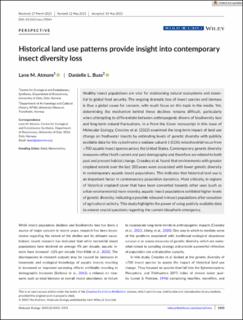| dc.contributor.author | Atmore, Lane | |
| dc.contributor.author | Buss, Danielle Lia | |
| dc.date.accessioned | 2023-09-11T06:39:53Z | |
| dc.date.available | 2023-09-11T06:39:53Z | |
| dc.date.created | 2023-06-22T13:15:22Z | |
| dc.date.issued | 2023 | |
| dc.identifier.citation | Molecular Ecology. 2023, 314 3353-3355. | en_US |
| dc.identifier.issn | 0962-1083 | |
| dc.identifier.uri | https://hdl.handle.net/11250/3088530 | |
| dc.description.abstract | Healthy insect populations are vital for maintaining natural ecosystems and essential to global food security. The ongoing dramatic loss of insect species and biomass is thus a global cause for concern, with much focus on this topic in the media. Yet, determining the mechanism behind these declines remains difficult, particularly when attempting to differentiate between anthropogenic drivers of biodiversity loss and long-term natural fluctuations. In a From the Cover manuscript in this issue of Molecular Ecology, Crossley et al. (2022) examined the long-term impact of land use change on freshwater insects by estimating levels of genetic diversity with publicly available data for the cytochrome c oxidase subunit 1 (CO1) mitochondrial locus from >700 aquatic insect species across the United States. Contemporary genetic diversity measures reflect both current and past demography and therefore are related to both past and present habitat change. Crossley et al. found that environments with greater cropland extent over the last 200 years were associated with lower genetic diversity in contemporary aquatic insect populations. This indicates that historical land use is an important factor in contemporary population dynamics. Most critically, in regions of historical cropland cover that have been converted towards other uses (such as urban environments) more recently, aquatic insect populations exhibited higher levels of genetic diversity, indicating a possible rebound in insect populations after cessation of agricultural activity. This study highlights the power of using publicly available data to answer crucial questions regarding the current biospheric emergency. | en_US |
| dc.language.iso | eng | en_US |
| dc.rights | Navngivelse 4.0 Internasjonal | * |
| dc.rights.uri | http://creativecommons.org/licenses/by/4.0/deed.no | * |
| dc.title | Historical land use patterns provide insight into contemporary insect diversity loss | en_US |
| dc.title.alternative | Historical land use patterns provide insight into contemporary insect diversity loss | en_US |
| dc.type | Peer reviewed | en_US |
| dc.type | Journal article | en_US |
| dc.description.version | publishedVersion | en_US |
| dc.source.pagenumber | 3353-3355 | en_US |
| dc.source.volume | 314 | en_US |
| dc.source.journal | Molecular Ecology | en_US |
| dc.identifier.doi | 10.1111/mec.17044 | |
| dc.identifier.cristin | 2157107 | |
| cristin.ispublished | true | |
| cristin.fulltext | original | |
| cristin.qualitycode | 2 | |

